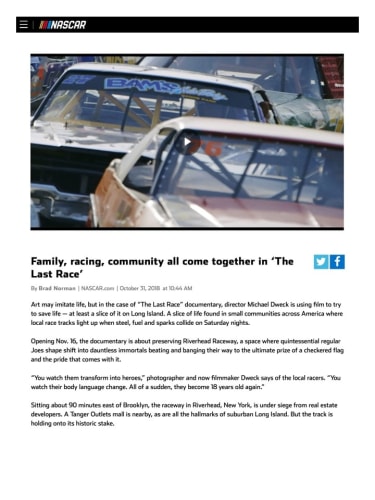Family, racing, community all come together in ‘The Last Race’
NASCAR
10/31/2018
Back
By Brad Norman
Art may imitate life, but in the case of “The Last Race” documentary, director Michael Dweck is using film to try to save life — at least a slice of it on Long Island. A slice of life found in small communities across America where local race tracks light up when steel, fuel and sparks collide on Saturday nights.
Opening Nov. 16, the documentary is about preserving Riverhead Raceway, a space where quintessential regular Joes shape shift into dauntless immortals beating and banging their way to the ultimate prize of a checkered flag and the pride that comes with it.
“You watch them transform into heroes,” photographer and now filmmaker Dweck says of the local racers. “You watch their body language change. All of a sudden, they become 18 years old again.”
Sitting about 90 minutes east of Brooklyn, the raceway in Riverhead, New York, is under siege from real estate developers. A Tanger Outlets mall is nearby, as are all the hallmarks of suburban Long Island. But the track is holding onto its historic stake.
Riverhead is one of the oldest race tracks in the country. Built in 1949, the track opened in 1951 and is a quarter-mile asphalt oval with high banking and sports a unique Figure 8 course. Home to NASCAR Whelen All-American Series racing, Riverhead also hosts demolition derbies, enduro races and the Rusty Wallace Racing Experience.
It’s the only small track remaining in the New York metro area, where Dweck recalls having 40 similar tracks within driving distance in his childhood.
“The Last Race” has layers of competition and battle — man vs. man, man vs. machine and man vs. the shifting culture in 21st century America. At the heart of the cultural clash is the racing.
Dweck studied racing films such as “Grand Prix,” “Senna” and “Rush.” But he also wanted to surpass them. With his first feature-length film being selected for the 2018 Sundance Film Festival, his goal is in hand.
“I was trying to beat these films,” Dweck said. “I was trying to figure out a way to have better racing footage than all these films. To do that I ended up welding 20 cameras around the race car. Not little cameras. Movie cameras around the race car.
“So when you watch the film and you see bumpers smashing, they’re smashing my cameras. Same with sides because in this division you can make contact. So when you see the film on a giant, 100-foot screen, a car taking up the screen crashing and just ‘boom, boom,’ you look at their grilles and all of these beautiful welded pipe cages and chains loose … you know it’s like ‘Mad Max.’ You get the feeling like you’re at the race track, like ‘Mad Max.’
Dweck poured the same care into the sound.
“I had 15 microphones placed all around the race cars. Everywhere, meaning the bumper, the carburetor, all along the tail pipe … on the brakes, on their feet, inside their helmets. You can hear the breathing when he puts on his helmet.
“So you get the feeling of what it’s like to be the car, to be the driver and to be the audience.”
The racing comes alive, as do the racers. But the drivers aren’t the only heroes in this tale. Barbara and Jim Cromarty are in their 80s, and the five-year time span captured in the film spans the years they transformed from owners who were physically active to a couple suffering physical ailments and finally selling the track to a trucking company owner with the agreement that he would keep it open.
“They were worried that if they retired, they would die,” Dweck said of the Cromartys, who had operated Riverhead since 1977 and owned it since 1985. “Most of their friends who retired had died. They didn’t want to be one of those. Their story is a beautiful story of resilience, of tenacity, of conscience – doing something greater than yourself. Because they could have walked away with a lot of money.
“I was there in a little trailer at the race track that’s the office … when a developer would knock at the door and they’d say ‘Hi, I’m from the shopping mall across the street, I’d like to talk to you,’ and she’d yell, ‘Get out!’ ”
The Cromartys rejected offers of up to $10 million from developers, as the film documents colorfully. In the end they sold it for much less – reportedly $4 million – in order to try to keep the lights on and engines roaring on Saturday nights.
Several drivers in NASCAR’s top series have been doing similar work, promoting dirt-track and small-track racing – the grassroots of stock car racing and birthplaces of legendary NASCAR driving careers.
Notably Denny Hamlin modeled his Darlington throwback paint scheme on his very first race car paint scheme for this year’s Southern 500. Hamlin drove at Langley Speedway and Southside Speedway in Virginia in his youth. Langley is a .397-mild paved oval that opened in 1950, and Southside is a .333-mile asphalt track that has been a locally owned family business since 1959.
Dweck’s labor of love is his effort to feed the recent surge in interest in these small local tracks, particularly on Long Island.
“I’m trying to do what I can to keep big box stores from taking over places like this all over the country,” he said. “The track is the last stronghold for their way of life.”